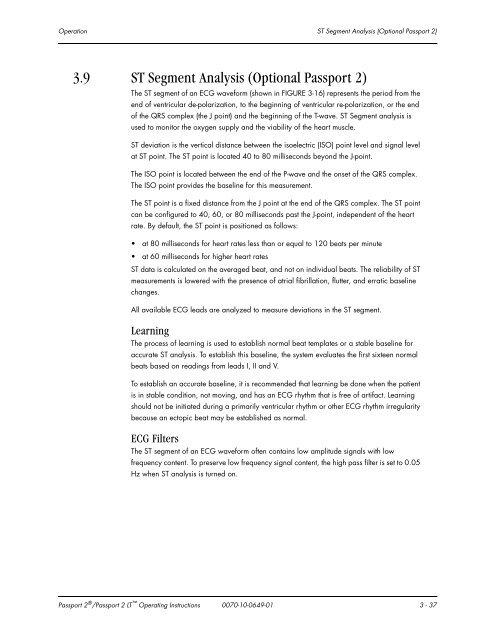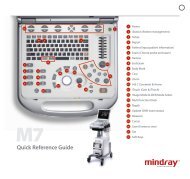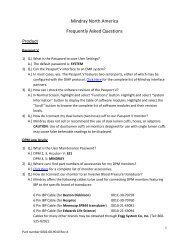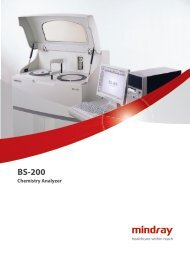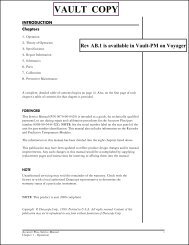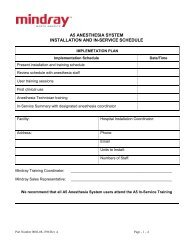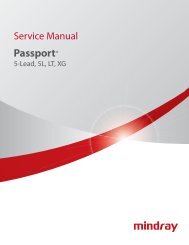Datascope Passport - Mindray
Datascope Passport - Mindray
Datascope Passport - Mindray
You also want an ePaper? Increase the reach of your titles
YUMPU automatically turns print PDFs into web optimized ePapers that Google loves.
Operation ST Segment Analysis (Optional <strong>Passport</strong> 2)<br />
3.9 ST Segment Analysis (Optional <strong>Passport</strong> 2)<br />
The ST segment of an ECG waveform (shown in FIGURE 3-16) represents the period from the<br />
end of ventricular de-polarization, to the beginning of ventricular re-polarization, or the end<br />
of the QRS complex (the J point) and the beginning of the T-wave. ST Segment analysis is<br />
used to monitor the oxygen supply and the viability of the heart muscle.<br />
ST deviation is the vertical distance between the isoelectric (ISO) point level and signal level<br />
at ST point. The ST point is located 40 to 80 milliseconds beyond the J-point.<br />
The ISO point is located between the end of the P-wave and the onset of the QRS complex.<br />
The ISO point provides the baseline for this measurement.<br />
The ST point is a fixed distance from the J point at the end of the QRS complex. The ST point<br />
can be configured to 40, 60, or 80 milliseconds past the J-point, independent of the heart<br />
rate. By default, the ST point is positioned as follows:<br />
at 80 milliseconds for heart rates less than or equal to 120 beats per minute<br />
at 60 milliseconds for higher heart rates<br />
ST data is calculated on the averaged beat, and not on individual beats. The reliability of ST<br />
measurements is lowered with the presence of atrial fibrillation, flutter, and erratic baseline<br />
changes.<br />
All available ECG leads are analyzed to measure deviations in the ST segment.<br />
Learning<br />
The process of learning is used to establish normal beat templates or a stable baseline for<br />
accurate ST analysis. To establish this baseline, the system evaluates the first sixteen normal<br />
beats based on readings from leads I, II and V.<br />
To establish an accurate baseline, it is recommended that learning be done when the patient<br />
is in stable condition, not moving, and has an ECG rhythm that is free of artifact. Learning<br />
should not be initiated during a primarily ventricular rhythm or other ECG rhythm irregularity<br />
because an ectopic beat may be established as normal.<br />
ECG Filters<br />
The ST segment of an ECG waveform often contains low amplitude signals with low<br />
frequency content. To preserve low frequency signal content, the high pass filter is set to 0.05<br />
Hz when ST analysis is turned on.<br />
<strong>Passport</strong> 2 ® /<strong>Passport</strong> 2 LT Operating Instructions 0070-10-0649-01 3 - 37


